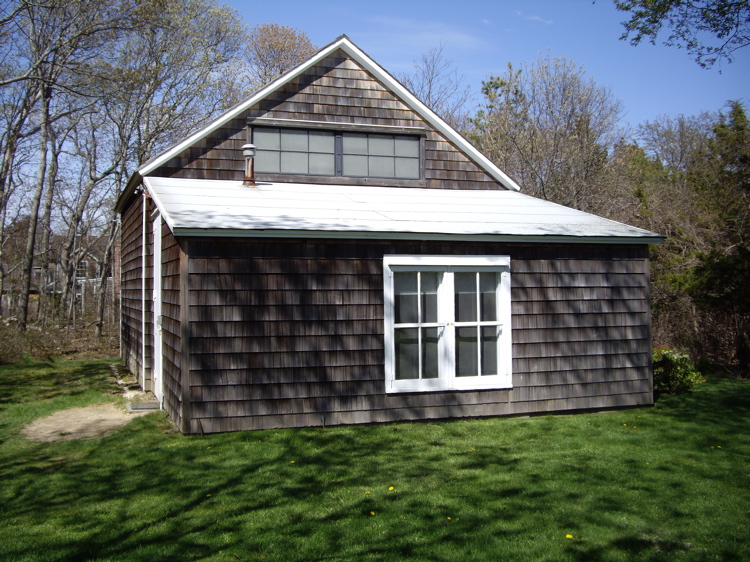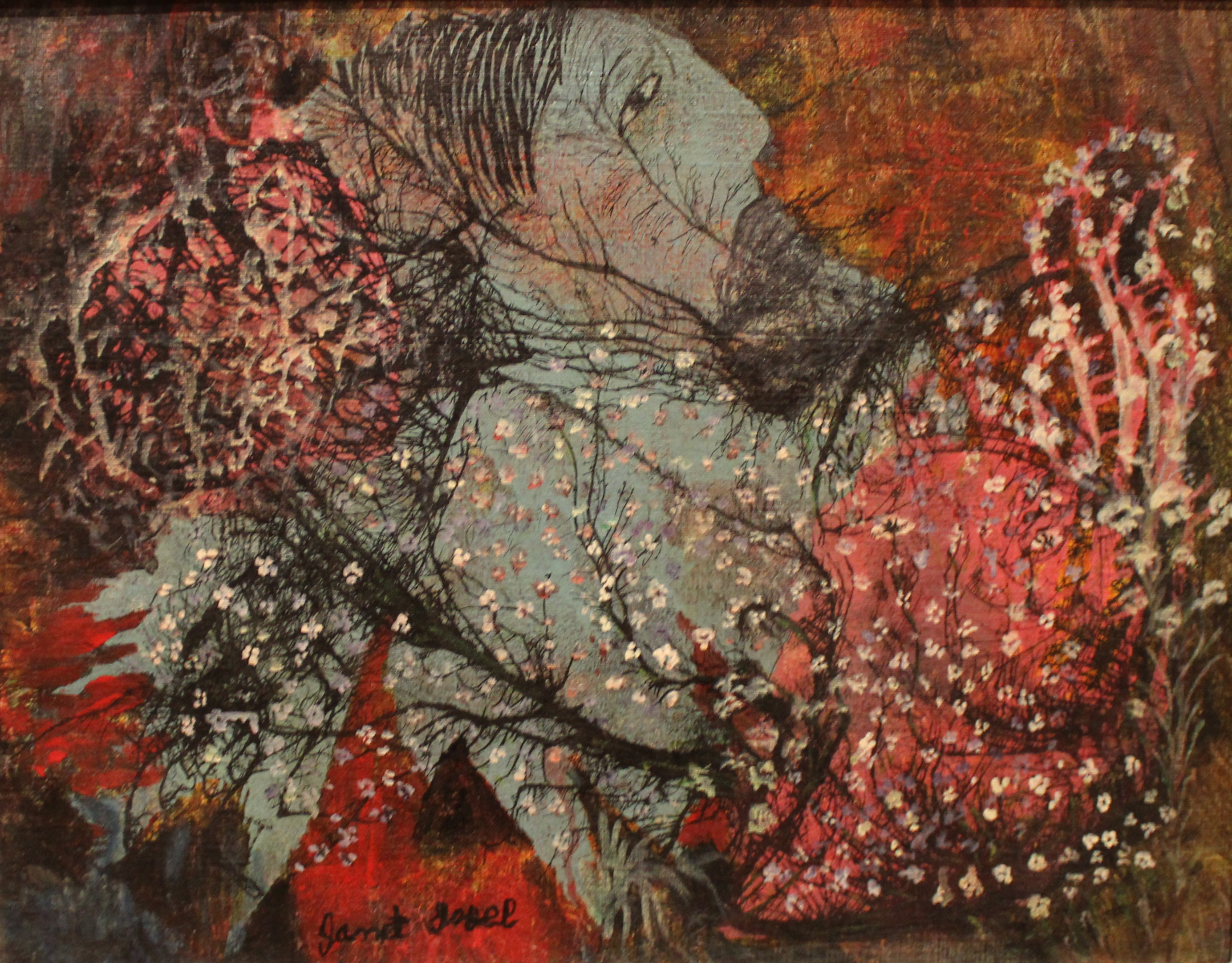|
All-over Painting
All-over painting refers to the non-differential treatment of the surface of a work of two-dimensional art, for instance a painting. This concept is most popularly thought of as emerging in relation to the so-called "drip" paintings of Jackson Pollock and the "automatic writing" or "abstract calligraphy" of Mark Tobey in the 1950s, though the applicability of the term all-over painting would be wider than that. "All-over painting" is not a formal style of painting and the term does not represent an "art movement." Some painting under the heading color field painting displays the "all-over" painting style. Such a painting would fail to treat the top, for instance, differently from the bottom; the left than the right. Uniform treatment of all sections of the surface are the hallmark of all-over painting. All-over paintings would lack a dominant point of interest, or any indication of which way is "up." Some paintings by Cy Twombly have had this term applied to them. Clement Greenberg ... [...More Info...] [...Related Items...] OR: [Wikipedia] [Google] [Baidu] |
Jackson Pollock
Paul Jackson Pollock (; January 28, 1912August 11, 1956) was an American painter and a major figure in the abstract expressionist movement. He was widely noticed for his " drip technique" of pouring or splashing liquid household paint onto a horizontal surface, enabling him to view and paint his canvases from all angles. It was called all-over painting and action painting, since he covered the entire canvas and used the force of his whole body to paint, often in a frenetic dancing style. This extreme form of abstraction divided the critics: some praised the immediacy of the creation, while others derided the random effects. In 2016, Pollock's painting titled ''Number 17A'' was reported to have fetched US$200 million in a private purchase. A reclusive and volatile personality, Pollock struggled with alcoholism for most of his life. In 1945, he married the artist Lee Krasner, who became an important influence on his career and on his legacy. Pollock died at the age of 44 in an ... [...More Info...] [...Related Items...] OR: [Wikipedia] [Google] [Baidu] |
Mark Tobey
Mark George Tobey (December 11, 1890 – April 24, 1976) was an American painter. His densely structured compositions, inspired by Asian calligraphy, resemble Abstract expressionism, although the motives for his compositions differ philosophically from most Abstract Expressionist painters. His work was widely recognized throughout the United States and Europe. Along with Guy Anderson, Kenneth Callahan, Morris Graves, and William Cumming, Tobey was a founder of the Northwest School. Senior in age and experience, he had a strong influence on the others; friend and mentor, Tobey shared their interest in philosophy and Eastern religions. Similar to others of the Northwest School, Tobey was mostly self-taught after early studies at the Art Institute of Chicago. In 1921, Tobey founded the art department at The Cornish School in Seattle, Washington.Cornish, Nellie C. "Miss Aunt Nellie: The Autobiography of Nellie C. Cornish". Seattle, University of Washington, 1964, p. 134-35 Tobey ... [...More Info...] [...Related Items...] OR: [Wikipedia] [Google] [Baidu] |
Art Movement
An art movement is a tendency or style in art with a specific common philosophy or goal, followed by a group of artists during a specific period of time, (usually a few months, years or decades) or, at least, with the heyday of the movement defined within a number of years. Art movements were especially important in modern art, when each consecutive movement was considered as a new avant-garde movement. Western art had been, from the Renaissance up to the middle of the 19th century, underpinned by the logic of perspective and an attempt to reproduce an illusion of visible reality ( figurative art). By the end of the 19th century many artists felt a need to create a new style which would encompass the fundamental changes taking place in technology, science and philosophy ( abstract art). Concept According to theories associated with modernism and the concept of postmodernism, ''art movements'' are especially important during the period of time corresponding to modern art. The per ... [...More Info...] [...Related Items...] OR: [Wikipedia] [Google] [Baidu] |
Cy Twombly
Edwin Parker "Cy" Twombly Jr. (; April 25, 1928July 5, 2011) was an American Painting, painter, Sculpture, sculptor and photographer. He belonged to the generation of Robert Rauschenberg and Jasper Johns. Twombly is said to have influenced younger artists such as Anselm Kiefer, Francesco Clemente, Julian Schnabel and Jean-Michel Basquiat. His best-known works are typically large-scale, freely-scribbled, Calligraphy, calligraphic and graffiti, graffiti-like works on solid fields of mostly gray, tan, or off-white colors. His later paintings and works on paper shifted toward "romantic symbolism", and their titles can be interpreted visually through shapes and forms and words. Twombly often quoted poets such as Stéphane Mallarmé, Rainer Maria Rilke and John Keats, as well as classical myths and allegories, in his works. Examples of this are his ''Apollo and The Artist'' and a series of eight drawings consisting solely of inscriptions of the word "VIRGIL". Twombly's works are in ... [...More Info...] [...Related Items...] OR: [Wikipedia] [Google] [Baidu] |
Clement Greenberg
Clement Greenberg () (January 16, 1909 – May 7, 1994), occasionally writing under the pseudonym K. Hardesh, was an American essayist known mainly as an art critic closely associated with American modern art of the mid-20th century and a formalist aesthetician. He is best remembered for his association with the art movement abstract expressionism and the painter Jackson Pollock. Early life Clement Greenberg was born in the borough of the Bronx, NYC, in 1909. His parents were middle-class Jewish immigrants, and he was the eldest of their three sons. Since childhood, Greenberg sketched compulsively, until becoming a young adult, when he began to focus on literature. Greenberg attended Erasmus Hall High School, the Marquand School for Boys, then Syracuse University, graduating with an A.B. in 1930, cum laude, Phi Beta Kappa. After college, already as fluent in Yiddish and English since childhood, Greenberg taught himself Italian and German in addition to French and Latin. Dur ... [...More Info...] [...Related Items...] OR: [Wikipedia] [Google] [Baidu] |
Janet Sobel
Janet Sobel (May 31, 1893 – November 11, 1968), born Jennie Olechovsky (occ. Lechovsky), was a Ukrainian-born American Abstract Expressionist painter whose career started mid-life, at age forty-five in 1938. Sobel pioneered the drip painting technique that directly influenced Jackson Pollock. She was credited as exhibiting the first instance of all-over painting seen by Clement Greenberg, a notable art critic. Early life Janet Sobel was born as Jennie Olechovsky in 1893 in Katerynoslav, Russian Empire (now Dnipro, Ukraine). Her father, Baruch Olechovsky, was killed in a Russian pogrom. Sobel moved to Ellis Island in New York City with her mother, Fannie Kinchuk, a midwife, and her siblings in 1908. Two years later, she married Max Sobel, a fellow emigrant from the Ukraine, with whom she had five children. She was already a grandmother when she began painting in 1937. She produced both non-objective abstractions and figurative artwork. Upon recognizing Sobel's talent, her so ... [...More Info...] [...Related Items...] OR: [Wikipedia] [Google] [Baidu] |
Action Painting
Action painting, sometimes called "gestural abstraction", is a style of painting in which paint is spontaneously dribbled, splashed or smeared onto the canvas, rather than being carefully applied. The resulting work often emphasizes the physical act of painting itself as an essential aspect of the finished work or concern of its artist. Background The style was widespread from the 1940s until the early 1960s, and is closely associated with abstract expressionism (some critics have used the terms "action painting" and "abstract expressionism" interchangeably). A comparison is often drawn between the American action painting and the French tachisme. The New York School of American Abstract Expressionism (1940s-50s) is also seen as closely linked to the movement. The term was coined by the American critic Harold Rosenberg in 1952, in his essay "The American Action Painters", and signaled a major shift in the aesthetic perspective of New York School painters and critics. Accordi ... [...More Info...] [...Related Items...] OR: [Wikipedia] [Google] [Baidu] |
Avant-garde Art
The avant-garde (; In 'advance guard' or 'vanguard', literally 'fore-guard') is a person or work that is experimental, radical, or unorthodox with respect to art, culture, or society.John Picchione, The New Avant-garde in Italy: Theoretical Debate and Poetic Practices' (Toronto: University of Toronto Press, 2004), p. 64 . It is frequently characterized by aesthetic innovation and initial unacceptability.Kostelanetz, Richard, ''A Dictionary of the Avant-Gardes'', Routledge, May 13, 2013 The avant-garde pushes the boundaries of what is accepted as the or the '' [...More Info...] [...Related Items...] OR: [Wikipedia] [Google] [Baidu] |
Abstract Expressionism
Abstract expressionism is a post–World War II art movement in American painting, developed in New York City in the 1940s. It was the first specifically American movement to achieve international influence and put New York at the center of the Western art world, a role formerly filled by Art in Paris, Paris. Although the term "abstract expressionism" was first applied to American art in 1946 by the art critic Robert Coates (critic), Robert Coates, it had been first used in Germany in 1919 in the magazine ''Der Sturm'', regarding German Expressionism. In the United States, Alfred Barr was the first to use this term in 1929 in relation to works by Wassily Kandinsky. Style Technically, an important predecessor is surrealism, with its emphasis on spontaneous, Surrealist automatism, automatic, or subconscious creation. Jackson Pollock's dripping paint onto a canvas laid on the floor is a technique that has its roots in the work of André Masson, Max Ernst, and David Alfaro Siqu ... [...More Info...] [...Related Items...] OR: [Wikipedia] [Google] [Baidu] |
Contemporary Art
Contemporary art is the art of today, produced in the second half of the 20th century or in the 21st century. Contemporary artists work in a globally influenced, culturally diverse, and technologically advancing world. Their art is a dynamic combination of Medium (arts), materials, methods, concepts, and subjects that continue the challenging of boundaries that was already well underway in the 20th century. Diverse and eclectic, contemporary art as a whole is distinguished by the very lack of a uniform, organising principle, ideology, or "-ism". Contemporary art is part of a cultural dialogue that concerns larger contextual frameworks such as personal and cultural identity, family, community, and nationality. In vernacular English, ''modern'' and ''contemporary'' are synonyms, resulting in some conflation and confusion of the terms ''modern art'' and ''contemporary art'' by non-specialists. Scope Some define contemporary art as art produced within "our lifetime," recognising tha ... [...More Info...] [...Related Items...] OR: [Wikipedia] [Google] [Baidu] |

.jpg)



